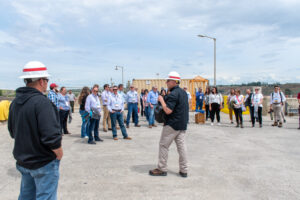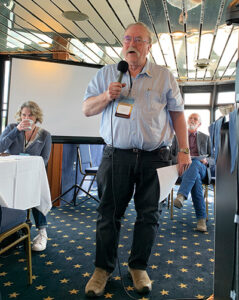By Trista Crossley, Editor, Wheat Life Magazine
Last month during a tour through Eastern Washington that included a boat ride to Ice Harbor Dam and a tour of the facility, members of the Congressional Western Caucus learned about the energy infrastructure the lower Snake River dams provide and the measures the U.S. Army Corps of Engineers has implemented to boost salmon survival. The Washington Association of Wheat Growers was one of the sponsors of the tour.

The tour was led by Rep. Dan Newhouse (R-Wash.), chairman of the Congressional Western Caucus, and included Caucus Vice Chair Bruce Westerman (R-Ark.) and members Rep. Mariannette Miller-Meeks (R-Iowa), Rep. Cliff Bentz (R-Ore.) and Rep. Matt Rosendale (R-Mont.). The legislators were joined by local producers and industry stakeholders, as well as staff from other congressional offices. The Congressional Western Caucus advocates for rural policy issues, especially across the West, including encouraging responsible resource development and energy independence; increasing access to public lands and promoting multiple-use policies; and supporting the nation’s farmers, ranchers and agriculture industry.
The dam tour began in Richland, with the farm bureau presidents of California, Idaho, Oregon and Washington summarizing the issues faced by their agricultural communities. All four presidents highlighted water/drought, availability of labor, cost of inputs, and burdensome regulations as issues farmers in their states were dealing with.
Tom Kammerzell, a wheat grower from Whitman County and a commissioner for the Port of Whitman County, represented the agriculture industry on a local industry panel. He explained that trucking wheat from in-country elevators to the river and then barging the grain to export terminals in Portland was the cheapest method of transportation for wheat farmers. Wheat farmers already have to contend with variable wheat prices and input costs, he told the group, “so we need a river system that is reliable.”
Others on the industry panel were Matt Harris, director of governmental affairs for the Washington Potato Commission, representing irrigators; Kristin Meira, director of government affairs for American Cruise Lines, representing tourism; and Rob Rich, vice president of marine services at Shaver Transportation, representing the transportation industry.

Alex McGregor, chairman of The McGregor Company, touched on the history of the Columbia Basin, how the dams made irrigation possible and let agriculture flourish. He also noted that the railroads don’t have the capacity to make up for the loss of barging if the dams were breached.
“The goal is for people to come together and find holistic solutions,” he said, thanking the legislators for taking the time to learn about the river system.
Rick Dunn, general manager of the Benton Public Utility District, talked about energy policies and the reliability of the western power grid that coordinates and depends on the energy generated by the lower Snake River dams. He pointed out that California is very dependent on Pacific Northwest load balancing, and the dams are an integral part of that.
“Hydro is foundational,” he said.
As the boat approached Ice Harbor Dam and prepared to enter the lock, Heather Stebbings, executive director of the Pacific Northwest Waterways Association, and Kurt Miller, executive director of Northwest River Partners, looked at the challenges related to the dams, especially ongoing and persistent litigation. Finally, representatives of the U.S. Army Corps of Engineers, the federal agency responsible for the management of the dams, talked about how fish are moved through and around the dams.
Once through the lock, the group disembarked and toured Ice Harbor Dam before boarding a bus to return to Richland. The day wrapped up with a reception at the Washington State University Wine Science Center that featured foods crafted with regional ingredients.
This article originally appeared in the July 2022 issue of Wheat Life Magazine.
